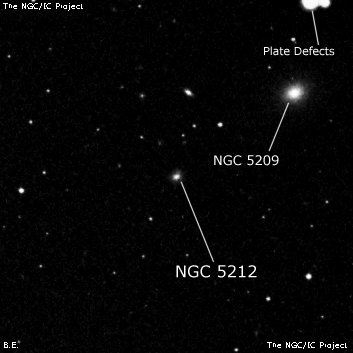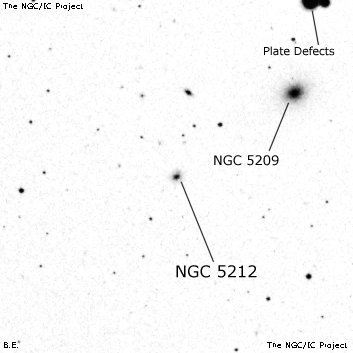NGC/IC Project Restoration Effort
(This is a very very beta version)
NGC5212


Basic Information
Location and Magnitude
Right Ascension: 13:32:56.1
Declination: +7:17:17
Constellation: VIR
Visual Magnitude: 14.3
Historic Information
Discoverer: Herschel J.
Year of discovery: 1830
Discovery aperture: 18.3
Observational
Summary description: eF
Sub-type: S
Corwin's Notes
=====
NGC 5212. Seen by John Herschel on only one night, and described simply as
"extremely faint," the only thing close to his position is a wide double star
(separation about 20 arcsec). Wolfgang Steinicke chose this double as N5212.
JH has other doubles mistaken as nebulae in his lists -- though they usually
have smaller separations than this. Because his position is within his
nominal errors of the double, this is at least a candidate for his object.
But there are other possibilities. Sue French sent a note early in May 2005
asking about CGCG 045-008 (NGC2000 and Glen Deen also picked this galaxy as
their candidate for N5212). This is close to two other galaxies (found by
WH), NGC 5208 and NGC 5209, that JH saw the same night as he did his "nova".
However, his "eF" nebula follows the other two by 50 seconds of time, while
CGCG 045-008 is between the two brighter galaxies in RA. There is no easy
digit error that would shift JH's RA to match that of CGCG 045-008, though the
declinations are identical. The faint galaxy is also close southeast of NGC
5208, so I think that had he seen it, JH would have commented on its proximity
to the brighter object (and his position for NGC 5208 is excellent, too).
Steve Gottlieb and Malcolm Thomson have suggested three other galaxies that
might be Sir John's object. One is CGCG 045-021, 10 arcmin south but 13
seconds of time east of JH's position. CGCG 045-012 is 30 seconds of time
west but 6 arcmin north. Finally, my own choice is the one that Malcolm and
Steve also favor in the end: CGCG 045-014, 27 seconds of time straight west
of JH's position. This is the second brightest of the three, and has the
highest surface brightness. Those factors, along with the offset (close
enough to 30 seconds, a common error), make this galaxy, too, a candidate for
JH's object.
Is there a possibility of systematic errors in the positions in this sweep?
For NGC 5208 and 5209, his positions are very good. In addition, his position
for 60 Virginis, the nearest bright star in the sweep, is within 5 arcseconds
of the modern position. So, we do not have any systematic offsets here to
help us.
In the past, I favored the double star simply because it is the closest object
to JH's position. However, since I wrote all of that, I have checked the
Herschel Archive for JH's sweep 253 of 24 April 1830, where NGC 5212 is number
33. The first thing to note is that he misidentifies the nebula as H III 10
(which is NGC 5209) and calls the real III 10 a "nova" -- he obviously caught
this error before he published his observations in 1833. Second, there are no
errors in the reduction; re-reducing his observation using his position of 60
(sigma) Virginis as a reference recovers his published position to within a
few arcseconds in both coordinates.
I wondered about a wire error (see NGC 468 for more about these). The sweep
log notes that NGC 5212 was taken as it was exiting the field. However, if
the wire was recorded incorrectly, the RA would be further east by either 28
seconds of time (wire 2) or 59 seconds (wire 1). Both of the candidate
galaxies are west, and there is nothing at all that might have caught JH's eye
-- not even wide double stars -- at the suggested positions.
Given all this, my own guess is that JH's clock was somehow misread by 50
seconds, and that his object is CGCG 045-008 (this is about half a magnitude
brighter in V than is CGCG 045-014) taken as it was leaving the field.
Perhaps distracted by the two brighter galaxies, JH had to hurry his
observation of the faint "nova" and mis-recorded the time (well, it's a
possibility, I suppose ...). I've adjusted the colons and question marks in
the position table accordingly.
Steve's Notes
=====
NGC 5212
24" (6/1/13): faint to very faint, very small, round, 15" diameter. The NGC identification is very uncertain and could apply to CGCG 045-008 and perhaps a faint, wide double star near John Herschel's position.
17.5" (5/27/95): not found though observed well past the meridian.



